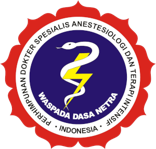Implementation of Enhanced Recovery After Caesarean Section (ERACS) in Elective Procedure : A Case Report
Abstract
Background: Enhanced Recovery After Cesarean Section (ERACS) protocol includes every component of the pre-operative, intra-operative and post-operative pathway. In the pre-operative phase, the protocol applied to this patient included the shortest possible fasting interval, oral intake of liquid carbohydrate and patient counselling. For intra-operative pathway, the components applied are prevention of hypotension, maintenance of normothermia, optimal uterotonic administration, IONV (intra-operative nausea and vomiting)/PONV (post-operative nausea and vomiting) prophylaxis, multi-modal analgesia and optimization of fluid administration. Post-operatively, the patient was given early nutritional intake, early mobilization, urinary catheter removal, venous thrombo-embolism prophylaxis, multi-modal analgesia and glycemic control. ERACS prove useful for early discharge, improving outcomes such as breastfeeding or reducing post-discharge opioid use.
Case Illustration: A 31-year-old woman came with the chief complaint of fluid discharge since ± 3 hours prior to admission to the hospital. Based on the medical history, physical examination, and laboratory findings, the patient was diagnosed with premature rupture of membranes in a gestational age of 37-38 weeks and had a live, single-headed presentation of the fetus. Patient’s physical status is ASA II and scheduled for elective C-section procedure with spinal anesthesia.
Conclusion: The implementation of the ERACS protocol in this case has been shown to reduce the rate of infection and post operative complications as well as reducing length of stay for the mother.
Keywords
Full Text:
PDFReferences
1. Adshead, D., Wrench, I. & Woolnough, M. Enhanced recovery for elective Caesarean section. BJA Educ. 20, 354–357 (2020).
2. Ogunkua, O. & Duryea, E. L. Enhanced recovery after cesarean section. Contemp. Ob. Gyn. 66, 16–19 (2021).
3. Caughey, A. B. et al. Guidelines for intraoperative care in cesarean delivery: Enhanced Recovery After Surgery Society Recommendations (Part 2). Am. J. Obstet. Gynecol. 219, 533–544 (2018).
4. Kemenkes RI. Laporan Nasional Riset Kesehatan Dasar. Kementeri. Kesehat. RI 1–582 (2018).
5. Nelson, G. & Macones, G. A. Despite barriers, Enhanced Recovery After Surgery for cesarean delivery should be prioritized in developing countries. Am. J. Obstet. Gynecol. 1 (2021).
6. Arora, A. & Jain, K. Enhanced Recovery After Surgery Society recommendations for scheduled cesarean deliveries: is the developing world ready? Am. J. Obstet. Gynecol. 224, 553–554 (2021).
7. Waili, M. Al & Kalbani, S. Al. Guideline for Enhanced Recovery after Caesarean Section. 5–27 (2019).
8. Meng, X., Chen, K., Yang, C., Li, H. & Wang, X. The Clinical Efficacy and Safety of Enhanced Recovery After Surgery for Cesarean Section: A Systematic Review and Meta-Analysis of Randomized Controlled Trials and Observational Studies. Front. Med. 8, (2021).
9. Pravina, P. & Tewary, K. Comparative study with or without application of enhanced recovery after surgery protocols in patients undergoing elective cesarean section. Int. J. Reprod. Contraception, Obstet. Gynecol. 10, 173 (2020).
10. Wilson, R. D. et al. Guidelines for Antenatal and Preoperative care in Cesarean Delivery: Enhanced Recovery After Surgery Society Recommendations (Part 1). Am. J. Obstet. Gynecol. 219, 523.e1-523.e15 (2018).
11. Bollag, L. et al. Society for Obstetric Anesthesia and Perinatology: Consensus Statement and Recommendations for Enhanced Recovery after Cesarean. Anesth. Analg. XXX, 1362–1377 (2021).
12. Clark, A. et al. Pre-operative carbohydrate loading prior to elective caesarean delivery: a randomised controlled trial. Int. J. Obstet. Anesth. 45, 21–27 (2021).
13. Licina, A., Silvers, A., Laughlin, H., Russell, J. & Wan, C. Pathway for enhanced recovery after spinal surgery-a systematic review of evidence for use of individual components. BMC Anesthesiol. 21, 1–21 (2021).
14. Elagamy, A. E., Kamaly, A. M., Shahin, M. I. & Saleh, M. Norepinephrine versus ephedrine for hypotension prophylaxis during cesarean section under spinal anesthesia. Ain-Shams J. Anesthesiol. 13, (2021).
15. Gallos, I. et al. Uterotonic agents for preventing postpartum haemorrhage : a network meta-analysis. Cochrane Database Syst. Rev. (2018). doi:10.1002/14651858.CD011689.pub2.www.cochranelibrary.com
16. Mba, S. G., Dim, C. C., Onah, H. E., Ezegwui, H. U. & Iyoke, C. A. Effects of early oral feeding versus delayed feeding on gastrointestinal function of post-caesarean section women in a tertiary hospital in Enugu, Nigeria: A randomized controlled trial. Niger. J. Clin. Pract. 22, 943–949 (2019).
17. Herman, A., Santoso, B. & Yunitasari, E. The Effect of Early Mobilization on Intestinal Peristaltics in Patients after a Cesarean Section in Kendari City Hospital. J. Ners 14, 288 (2020).
18. Macones, G. A. et al. Guidelines for postoperative care in cesarean delivery: Enhanced Recovery After Surgery (ERAS) Society recommendations (part 3). Am. J. Obstet. Gynecol. 221, 247.e1-247.e9 (2019).
Refbacks
- There are currently no refbacks.








